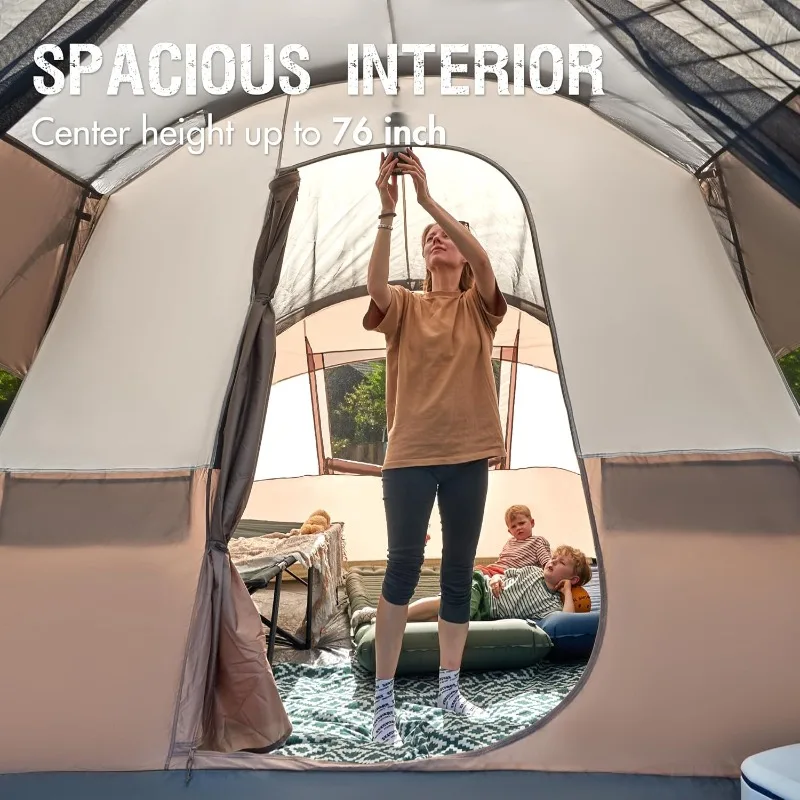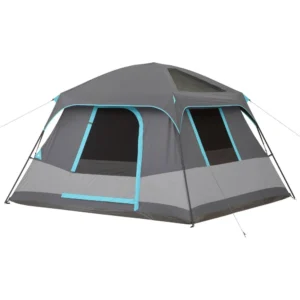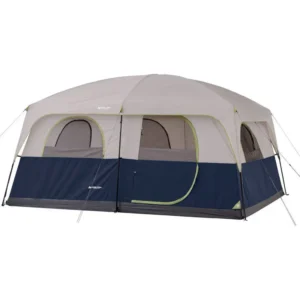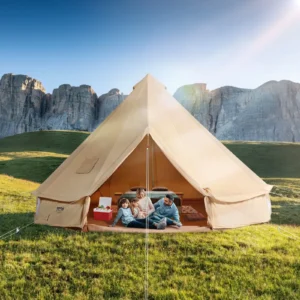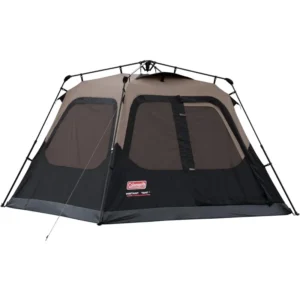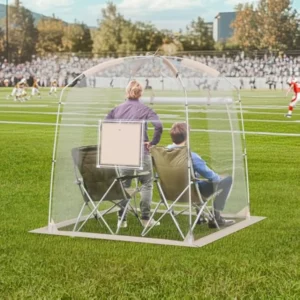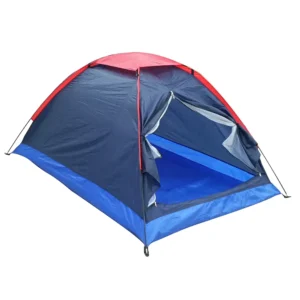Introduction
High-ceiling tents—defined as shelters with standing room of at least 6 feet (1.83 m) in height—represent a significant evolution in camping comfort. For many outdoor enthusiasts, traditional camping has long meant enduring hunched positions, awkward movements, and the constant discomfort of confined spaces. The simple addition of vertical space transforms these basic shelters into genuine living environments, creating an entirely different camping experience.
The benefits of increased tent height extend far beyond just being able to stand up straight. From enhanced physical comfort and improved daily routines to better climate control and increased livability, high-ceiling tents address many common camping frustrations. This shift from basic dome designs to more cabin-style structures reflects a growing understanding that tent selection should align with your specific camping style and needs, not just provide basic shelter.
As camping gear continues to evolve, understanding different shelter options for two campers helps you make better decisions about which features truly matter for your outdoor adventures. Let’s explore how something as simple as ceiling height can completely transform your time in the wilderness.
The Freedom of Standing Tall: Comfort and Movement
The most immediate benefit of high-ceiling tents is the liberation they provide for your body. With full standing heights of 6-7 feet (1.83-2.13 m), these tents eliminate the hunching, crouching, and awkward movements that characterize many camping experiences. This seemingly simple feature fundamentally changes how you interact with your shelter.
Physical benefits of standing height include:
- Relief from back and neck strain caused by constant stooping
- Natural movement that prevents muscle stiffness and cramping
- Ability to stretch fully after a day of hiking or outdoor activities
- Reduced physical fatigue during multi-day camping trips
- Better mobility for getting in and out of sleeping areas
Beyond the physical comfort, there’s also a significant psychological benefit. The ability to stand and move naturally creates a sense of spaciousness that combats the claustrophobia many people experience in standard tents. Rather than feeling confined to a cramped shelter, campers experience a genuine living space that promotes relaxation.
The difference becomes immediately apparent when performing common tasks. Changing clothes in a standard dome tent often involves a complicated series of contortions, while tall camping tents allow you to change standing up naturally. Similarly, unpacking and organizing gear becomes a comfortable activity rather than a frustrating exercise.
Simplified Daily Routines and Activities
The practical advantages of standing height become most evident in your daily camping routines. Morning and evening activities that might be awkward or challenging in standard tents transform into simple, comfortable tasks in high-ceiling models. This improvement in everyday functionality proves particularly valuable on longer camping trips.
Getting dressed or changed becomes remarkably straightforward when you can stand upright. Rather than struggling to pull on pants while lying down or crouching, you can comfortably change clothes just as you would at home. Similarly, personal grooming tasks like brushing hair, applying sunscreen, or freshening up become much easier when you can stand at full height.
For families with children, the benefits multiply. Parents can help children change clothes, get ready for bed, or put on shoes without cramping into uncomfortable positions. Bedtime routines become less stressful when adults can move freely while tucking children in or reading bedtime stories.
The increased height also transforms how campers organize their space and belongings. Items can be placed at accessible heights rather than sprawled across valuable floor space. Many easy-access tents for elderly campers incorporate standing height specifically because it addresses mobility concerns and simplifies camp life for those with physical limitations.
What might seem like small conveniences add up to a dramatically improved camping experience, especially on trips lasting more than a weekend. High ceilings transform a tent from merely a sleeping space to a true living environment where you can comfortably spend time regardless of weather conditions.
Creating a True Living Space: Enhanced Interior Environment
High-ceiling tents fundamentally change how campers perceive and utilize their temporary homes. The vertical space creates a genuine room-like environment rather than just a shelter, allowing for better organization, functionality, and comfort during extended stays.
The psychological impact of headroom shouldn’t be underestimated. Even when floor dimensions are identical, a tent with vertical walls and high ceilings feels substantially more spacious than a sloped-wall dome design. This perceived spaciousness contributes significantly to overall comfort, particularly during extended periods inside the tent.
High ceilings allow for interior organization that would be impossible in standard tents:
- Designated zones for sleeping, changing, and storage
- Space for camp furniture like chairs, tables, or cots
- Vertical storage options that preserve floor space
- Room for gear organization systems and hanging accessories
- Proper placement of lighting at useful heights
Many experienced campers find that standing tall in camping tents provides flexibility in how they structure their camping experience. Rather than simply having a place to sleep, they gain a legitimate living area that can accommodate various activities and needs. This becomes particularly valuable during inclement weather when more time is spent inside the tent.
The ability to incorporate furniture transforms how you use the space. Folding chairs, small tables, and storage units become practical additions rather than cumbersome obstacles. This furniture further enhances the home-like feeling, making extended camping trips significantly more comfortable and enjoyable.
Superior Climate Control and Ventilation
The increased volume of high-ceiling tents delivers substantial benefits for air quality and temperature regulation that many campers overlook. The physics of air circulation works in your favor with taller tent designs, creating a more comfortable environment in various weather conditions.
In warm weather, high ceilings allow hot air to rise above the living space, creating a cooler zone at occupant level. This natural stratification effect means that even without additional ventilation, the temperature at sleeping and sitting height often remains more comfortable than in standard tents. When combined with proper window and door placement, this height creates excellent cross-ventilation opportunities.
The ventilation advantages include:
- Reduced stuffiness during multi-person occupancy
- Lower humidity levels and less condensation on tent surfaces
- Better dissipation of cooking odors and moisture
- More effective placement of mesh panels and windows
- Improved air exchange between interior and exterior
During cooler conditions, the additional air volume serves as insulation, creating a buffer zone between occupants and the elements. With proper heating methods, the increased space also allows for safer warming options and better heat distribution throughout the living area.
For families or groups, these ventilation benefits become particularly important. Multiple occupants naturally generate more heat, moisture, and carbon dioxide, making proper air circulation essential for comfort and health. Tall stand-up camping tents provide the necessary volume to maintain air quality with multiple occupants over extended periods.
Weather Resilience and Shelter Quality
Contrary to common misconceptions, well-designed high-ceiling tents can offer excellent weather protection despite their larger profiles. Modern architectural approaches and materials allow these spacious shelters to withstand challenging conditions while maintaining their comfortable interior dimensions.
Key structural elements that contribute to stability include:
- Reinforced pole systems with additional cross-bracing
- Strategic guyline attachment points for wind resistance
- Stronger materials to support larger surface areas
- Corner reinforcements to maintain shape under load
- Advanced frame designs that distribute stress efficiently
The additional interior volume creates valuable buffer zones between campers and tent walls. This distance helps prevent the uncomfortable sensation of wet fabric contacting sleeping bags or gear during rainstorms—a common complaint with smaller, more confined tent designs where occupants inevitably touch the sides.
During extended periods of bad weather, the psychological comfort of a spacious shelter becomes particularly valuable. Rather than feeling trapped in a cramped space, campers can move around, reorganize gear, and maintain some sense of normalcy despite being tent-bound. This mental comfort significantly impacts the overall camping experience during challenging weather.
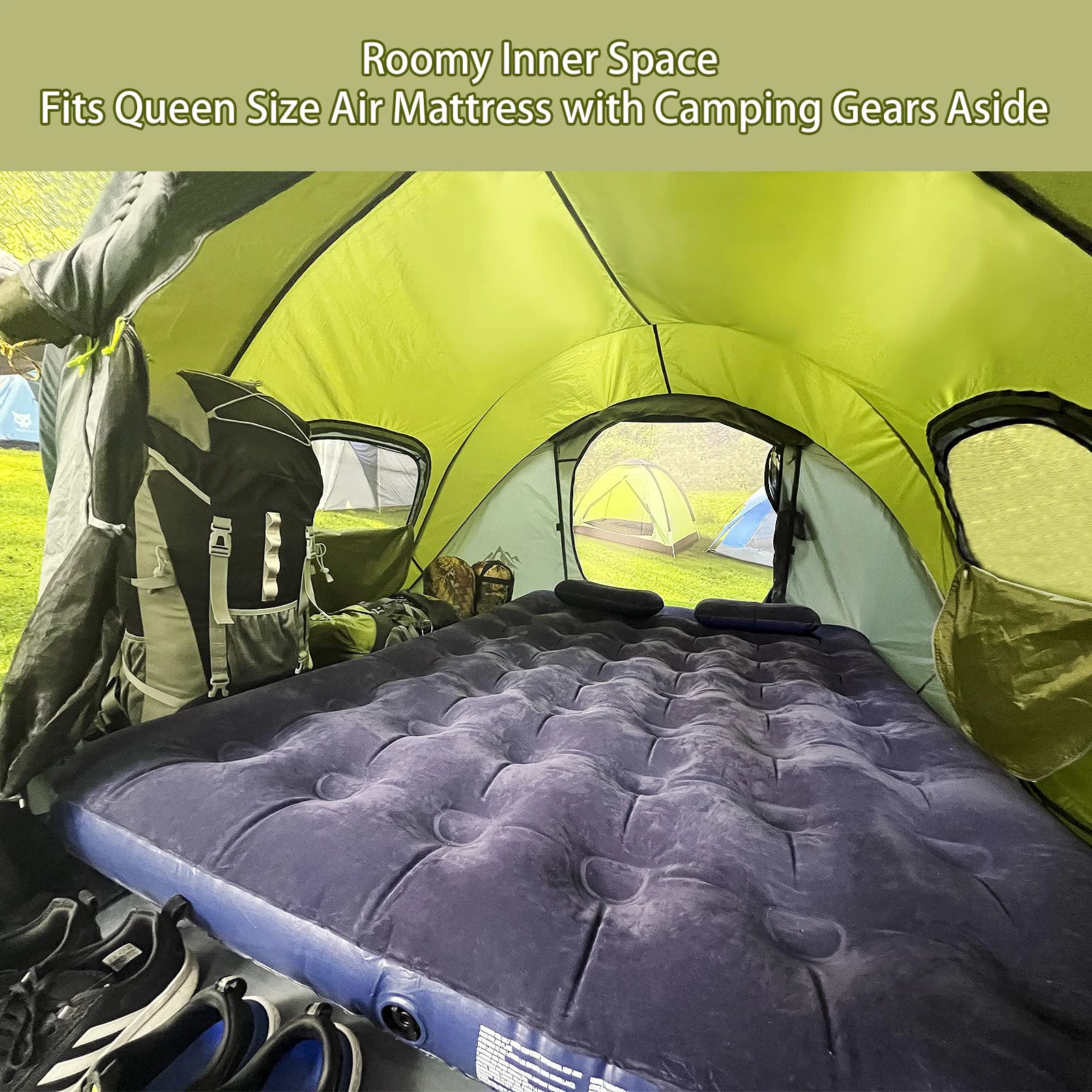
While some ultralight backpackers might question the wind performance of taller tents, manufacturers have developed sophisticated systems to ensure stability. Many two-room camping tents incorporate substantial reinforcement in their larger designs, allowing them to withstand significant wind while maintaining their spacious interiors.
Practical Advantages for Better Camping
Beyond comfort and environmental benefits, high-ceiling tents offer numerous practical advantages that enhance the overall camping experience. These functional improvements address common pain points and frustrations that many campers face with standard tent designs.
Entry and exit become remarkably easier with proper height. Rather than crawling or crouching through small openings, campers can walk naturally through appropriately sized doors. This improved access proves especially valuable for taller individuals who might otherwise need to perform awkward contortions to enter or exit their shelter.
Gear organization and accessibility transform with vertical space. Equipment can be:
– Hung from ceiling loops to dry or stay organized
– Placed on shelving units that utilize vertical space
– Stored in hanging pockets or organizers
– Arranged at comfortable retrieval heights
– Accessed without disturbing sleeping areas
Lighting options improve dramatically in high-ceiling tents. Lanterns and lights can hang at optimal heights, providing better illumination throughout the space rather than creating harsh shadows or hotspots. This proper lighting makes reading, game playing, and evening activities much more enjoyable.
For those with any mobility considerations, the advantages become even more significant. The freedom to move naturally, without crouching or awkward positions, makes camping more accessible and enjoyable for people with back issues, joint pain, or other physical limitations.
These practical features distinguish high-ceiling designs from traditional dome camping tents, which often prioritize simplicity and low weight over livability. While dome designs certainly have their place for certain applications, the practical advantages of vertical space significantly enhance the daily camping experience.
Perfect for Family Camping Adventures
Families with children benefit tremendously from the additional space and functionality of high-ceiling tents. The challenges of managing multiple people—especially young ones—in a confined outdoor environment become much more manageable with adequate vertical room.
During rainy days or downtime, high-ceiling tents provide children with play space that simply doesn’t exist in standard designs. Rather than being confined to sleeping bags or cramped sitting positions, kids can engage in quiet activities, games, or even light physical play inside the tent. This indoor activity option proves invaluable when weather conditions prevent outdoor exploration.
Parents find numerous advantages in the additional height:
– Easier assistance with clothing changes and bathroom trips
– More comfortable bedtime routines including reading and tucking in
– Better management of children’s gear and belongings
– Space for cooling down excited children before sleep
– Room for separate adult and children’s areas
The organization possibilities of two-room family tents combined with standing height create genuine living environments rather than just sleeping spaces. Many families find they can establish dedicated “kid zones” and “adult zones” within larger high-ceiling designs, allowing for some privacy and separation that makes extended camping more enjoyable for everyone.

Perhaps most importantly, the reduced stress and frustration of managing family life in a comfortable space versus a cramped one can fundamentally change how families experience camping. What might otherwise be a challenging exercise in patience becomes a comfortable adventure that creates positive memories and encourages future outdoor excursions.
Ideal for Extended Stays and Base Camping
The benefits of high-ceiling tents increase exponentially with the length of your camping trip. While a weekend warrior might reasonably tolerate crouching and confined spaces for a night or two, extended stays demand the comfort and functionality that only proper standing height can provide.
For base camping—where you establish a central campsite for multiple days of activities—high ceiling designs offer substantial advantages:
– Comfortable living space during downtime between excursions
– Proper organization systems that remain functional throughout longer stays
– Space for essential comfort items that enhance extended outdoor living
– Room to establish daily routines and living patterns
– Psychological comfort that prevents “tent fatigue”
Hunting camps, field research stations, seasonal camping, and other long-duration outdoor living situations particularly benefit from the home-like environment that high-ceiling tents provide. The ability to stand, stretch, and move naturally becomes increasingly important as days turn into weeks.
Many canvas camping tents feature high ceilings specifically because they’re designed for these extended applications. Their durable materials and spacious interiors create sustainable living environments rather than temporary shelters, allowing for comfortable long-term use in various conditions.
The proper vertical space also allows for development of more sophisticated camp systems over time. As you settle into a base camp, the organization and functionality can evolve to meet your specific needs—something that’s nearly impossible in confined, crouch-only designs where every square inch serves multiple competing purposes.
Design Considerations: Not All High-Ceiling Tents Are Equal
When evaluating high-ceiling tents, understanding key design distinctions helps ensure you select a model that delivers genuine benefits rather than just marketing claims. Not all “tall” tents provide the same functional advantages, and certain architectural approaches yield more usable space than others.
The critical distinction lies between peak height and wall height. Many tents advertise impressive center heights but have steeply sloped walls that dramatically reduce the functional standing area. The most comfortable high-ceiling designs feature:
– Vertical or near-vertical walls that maximize usable space
– Substantial areas (not just a central point) with full standing height
– Rectangular floor designs that complement vertical walls
– Frame systems that support height throughout the structure
– Thoughtful door placement aligned with standing areas
Different architectural approaches yield varying results:
– Cabin designs typically offer the most vertical wall space and rectangular footprints
– Modified domes might provide some standing height but with limited floor area
– Tunnel designs can combine good height with directional stability
– Hybrid designs may incorporate elements of multiple styles for balanced performance
Determining what size tent is good for 2 people or more requires looking beyond simple floor dimensions. The relationship between floor space and usable height dramatically impacts how spacious a tent actually feels in practice. A slightly smaller footprint with proper vertical walls often provides more functional living space than a larger dome with minimal standing room.
When reviewing specifications, pay particular attention to the area of the tent that maintains full height rather than just the maximum center height. This measurement more accurately reflects the functional advantage you’ll experience when using the tent in real camping situations.
Tall / Stand Up Camping Tent, Two Room Camping Tent
$407.93 Select options This product has multiple variants. The options may be chosen on the product page- $476.52 Select options This product has multiple variants. The options may be chosen on the product page
- $1,221.93 Select options This product has multiple variants. The options may be chosen on the product page
Easy Setup Camping Tent, Instant Camping Tent
Instant Cabin Tent Double Layer Canvas 1-Minute Setup Spacious Family Camping Shelter with Air Vents$308.10 Select options This product has multiple variants. The options may be chosen on the product pageEasy Setup Camping Tent, Trekking Pole Backpacking Tent
$142.40 Select options This product has multiple variants. The options may be chosen on the product page
Understanding the Trade-offs: When Height Comes at a Cost
While high-ceiling tents offer substantial benefits, honest assessment requires acknowledging the inherent trade-offs. Understanding these considerations helps you make informed decisions based on your specific camping priorities and needs.
Increased weight and packed size represent the most obvious compromises. The additional poles, fabric, and structural elements needed to create standing height add weight and bulk compared to lower-profile designs. This trade-off becomes particularly relevant for:
– Transportation with limited vehicle space
– Situations requiring manual carrying over significant distances
– Storage between camping trips
– Camping situations where frequent relocation is necessary
Wind vulnerability increases with tent height. Taller structures naturally capture more wind force, requiring:
– More robust anchoring systems
– Careful site selection with wind considerations
– Additional guylines in challenging conditions
– Stronger pole materials and construction
Setup complexity often increases with tent size and height. Many high-ceiling designs require:
– Multiple people for efficient assembly
– Longer setup times than simpler designs
– More complex pole structures and connections
– Greater attention to proper tensioning and staking
Cost implications can’t be ignored. The additional materials, more complex designs, and stronger components typically result in higher prices for high-ceiling models compared to standard tents with similar floor dimensions.
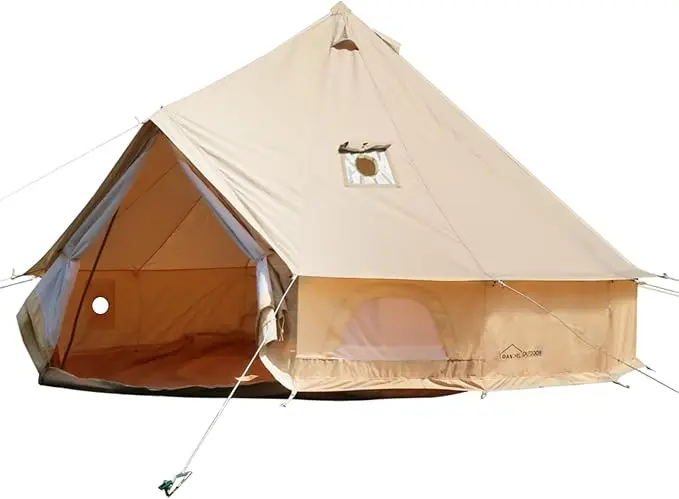
These factors don’t necessarily diminish the benefits of high-ceiling tents, but they do require honest evaluation based on your camping style. For many campers, particularly those engaging in tall tents for car camping, the comfort advantages far outweigh these considerations. Others, especially those prioritizing mobility or ultralight approaches, might find the trade-offs less acceptable.
Frequently Asked Questions About High-Ceiling Tents
What is considered a good standing height for most campers?
For most adults, a minimum of 6 feet (1.83 m) of ceiling height provides comfortable standing room. Taller individuals should look for ceilings of at least 6.5 feet (1.98 m) to ensure comfortable movement without stooping. Remember that usable height depends not just on peak measurements but on wall steepness and the area maintaining full height.
Are high-ceiling tents suitable for backpacking?
Generally, high-ceiling tents are not ideal for backpacking due to their increased weight and packed size. Most backpackers prioritize minimum weight over standing room. However, some lightweight tall tent designs might work for short-distance backpacking where comfort at the destination outweighs carrying convenience.
How do high-ceiling tents perform in strong winds?
Well-designed high-ceiling tents can perform adequately in strong winds when properly set up with all guylines and anchoring points utilized. However, they typically have more wind resistance than lower-profile designs. Look for models with strong pole structures, wind-responsive venting, and proper aerodynamic considerations if you frequently camp in windy conditions.
Do higher ceilings mean colder sleeping conditions?
Higher ceilings can create more air circulation, which may make the tent feel cooler on cold nights. However, proper tent design with adequate ventilation control, ground insulation, and appropriate sleeping gear mitigates this effect. Many campers find the temperature regulation benefits in warm weather outweigh any potential heat loss concerns in cooler conditions.
Is a High-Ceiling Tent Right for Your Camping Style?
The decision to invest in a high-ceiling tent should align with your specific camping priorities, frequency, and typical conditions. Different camping styles benefit differently from increased vertical space.
Family campers often find high-ceiling tents indispensable. The ability to manage children, organize gear, and create comfortable living spaces dramatically improves the family camping experience. The additional room for rainy-day activities and simplified childcare routines typically outweigh any setup or transportation challenges.
Car campers who prioritize comfort over minimal packed size are natural candidates for high-ceiling designs. When vehicle transportation eliminates weight concerns and trips focus on enjoying the destination rather than the journey, the enhanced livability of standing-height tents provides substantial benefits.
Extended-stay campers benefit tremendously from proper ceiling height. Whether you’re establishing a hunting camp, enjoying seasonal camping, or creating a base for multiple activities, the comfort of natural movement and proper organization becomes increasingly valuable as trip duration increases.
Some scenarios might favor standard tent designs despite the comfort advantages of height. Campers regularly facing extreme winds, those prioritizing absolute minimum weight, or those camping primarily as a simple sleeping shelter between daytime activities might reasonably opt for lower-profile designs.
Ultimately, understanding the transformation that proper tent zoning and configurations can bring to your camping experience helps determine if a high-ceiling tent will enhance your specific outdoor adventures. For most recreational campers, particularly those spending significant time in their shelter, the comfort and livability benefits make high-ceiling tents a worthwhile investment in outdoor enjoyment.

